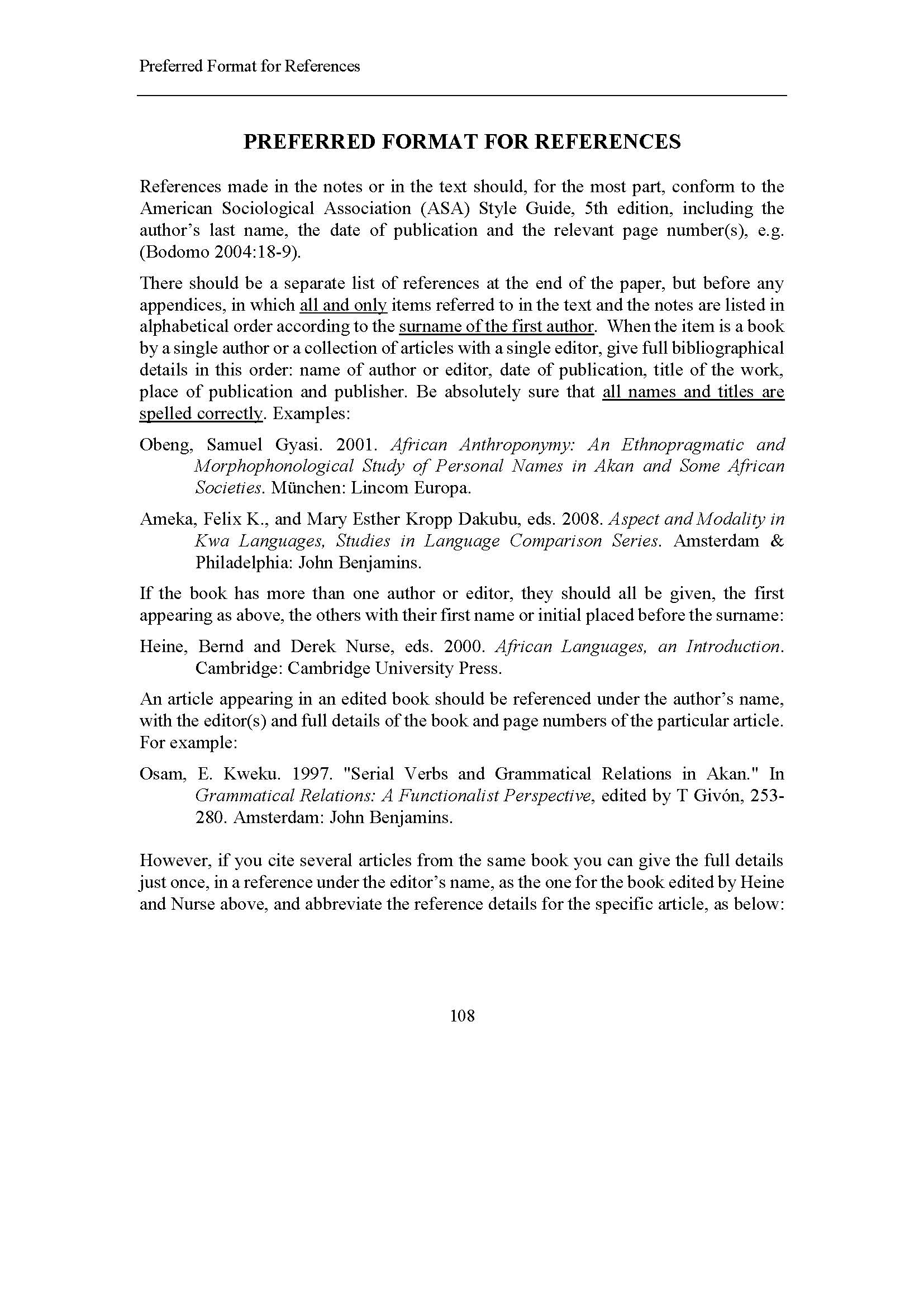Preferred Format for References
DOI:
https://doi.org/10.4314/gjl.v9i1.375Keywords:
preferred, format, referencesAbstract
PREFERRED FORMAT FOR REFERENCES
References made in the notes or in the text should, for the most part, conform to the American Sociological Association (ASA) Style Guide, 5th edition, including the author’s last name, the date of publication and the relevant page number(s), e.g. (Bodomo 2004:18-9).
There should be a separate list of references at the end of the paper, but before any appendices, in which all and only items referred to in the text and the notes are listed in alphabetical order according to the surname of the first author. When the item is a book by a single author or a collection of articles with a single editor, give full bibliographical details in this order: name of author or editor, date of publication, title of the work, place of publication and publisher. Be absolutely sure that all names and titles are spelled correctly. Examples:
Obeng, Samuel Gyasi. 2001. African Anthroponymy: An Ethnopragmatic and Morphophonological Study of Personal Names in Akan and Some African Societies. München: Lincom Europa.
Ameka, Felix K., and Mary Esther Kropp Dakubu, eds. 2008. Aspect and Modality in Kwa Languages, Studies in Language Comparison Series. Amsterdam & Philadelphia: John Benjamins.
If the book has more than one author or editor, they should all be given, the first appearing as above, the others with their first name or initial placed before the surname:
Heine, Bernd and Derek Nurse, eds. 2000. African Languages, an Introduction. Cambridge: Cambridge University Press.
An article appearing in an edited book should be referenced under the author’s name, with the editor(s) and full details of the book and page numbers of the particular article. For example:
Osam, E. Kweku. 1997. "Serial Verbs and Grammatical Relations in Akan." In Grammatical Relations: A Functionalist Perspective, edited by T Givón, 253-280. Amsterdam: John Benjamins.
However, if you cite several articles from the same book you can give the full details just once, in a reference under the editor’s name, as the one for the book edited by Heine and Nurse above, and abbreviate the reference details for the specific article, as below:
Bender, Lionel M. 2000. "Nilo-Saharan." Pp. 43–73 in African Languages: An Introduction, edited by B. Heine and D. Nurse. Cambridge: Cambridge University Press.
A journal article should be cited similarly to an article in an edited book. Note that the words ‘volume’, ‘number’ and ‘pages’ can be omitted, provided the correct punctuation is observed, as in the following:
Amfo, Nana Aba Appiah. 2010. “Noun Phrase Conjunction in Akan: The Grammaticalization Path.” Pragmatics 20 (1):27-41.
If the page numbering is continuous through all issues of the volume the ‘number’ itself can also be omitted:
Bresnan, Joan and Sam A. Mchombo. 1987. “Topic, pronoun and agreement in Chichewa.” Language 13:741-82.
Items in newspapers can be cited in the same way as journal articles. Unpublished papers will not have a place of publication or a publisher: simply add ‘ms’ (for ‘manuscript’), or the name and place of the meeting at which it was presented.
The editors will be grateful if you do NOT format your paragraphs including hanging and indented paragraphs by using the Return or Enter key and indents and spaces – please use the paragraph formatting menu!
References
N/A

Downloads
Published
How to Cite
Issue
Section
License
Copyright (c) 2020 Ghana Journal of Linguistics

This work is licensed under a Creative Commons Attribution 4.0 International License.
The Ghana Journal of Linguistics is published by the Linguistics Association of Ghana, P. O. Box LG 61, Legon, Accra, Ghana.
LAG Email: linguisticsgh@gmail.com. Website: http://www.laghana.org
GJL Email: gjl@laghana.org Website: http://www.laghana.org/gjl
© Linguistics Association of Ghana and individual authors, 2023.
